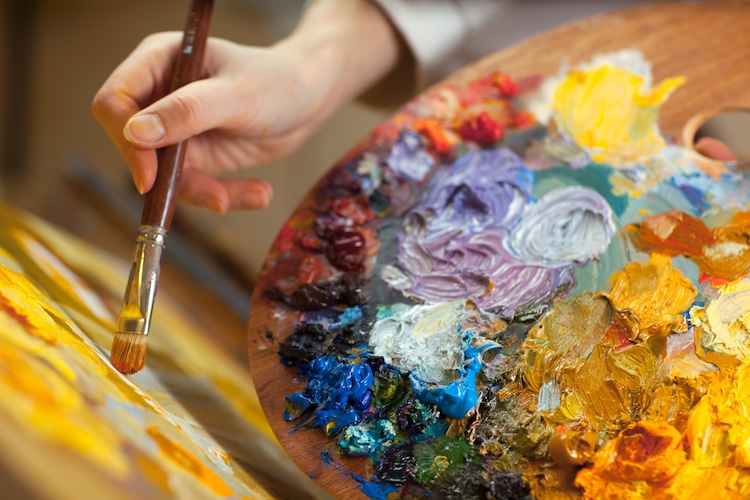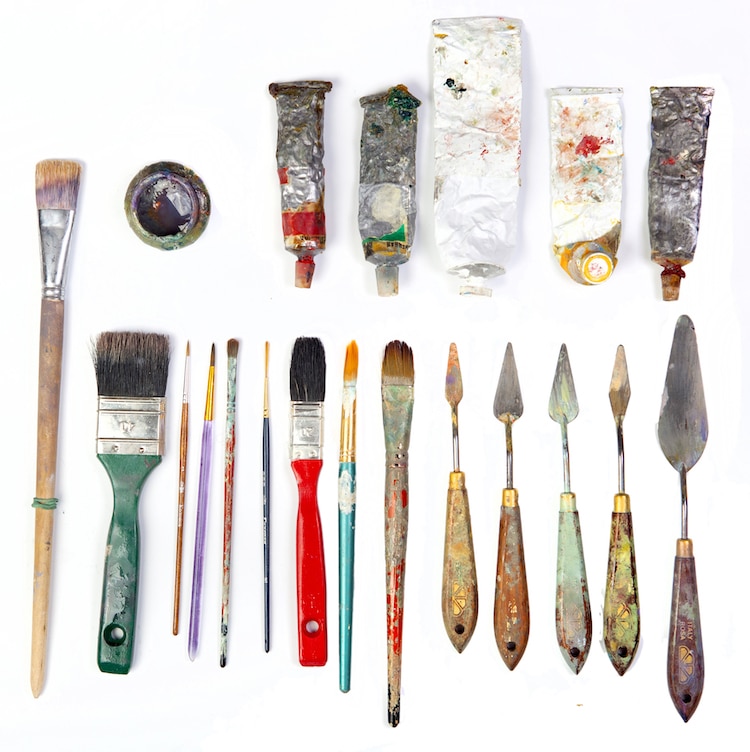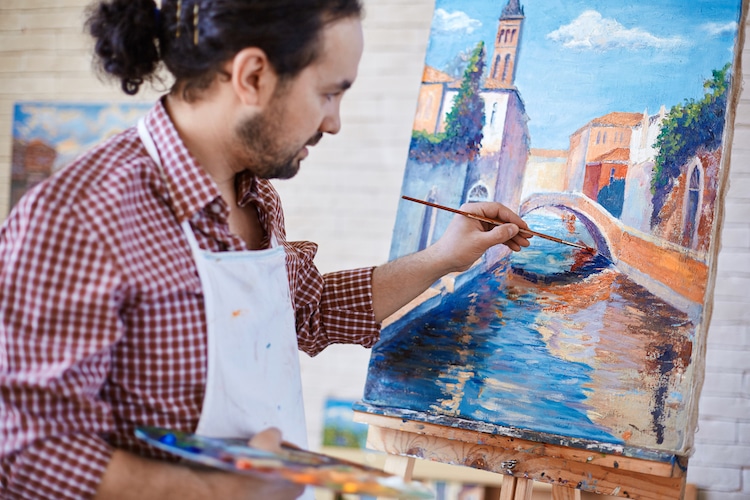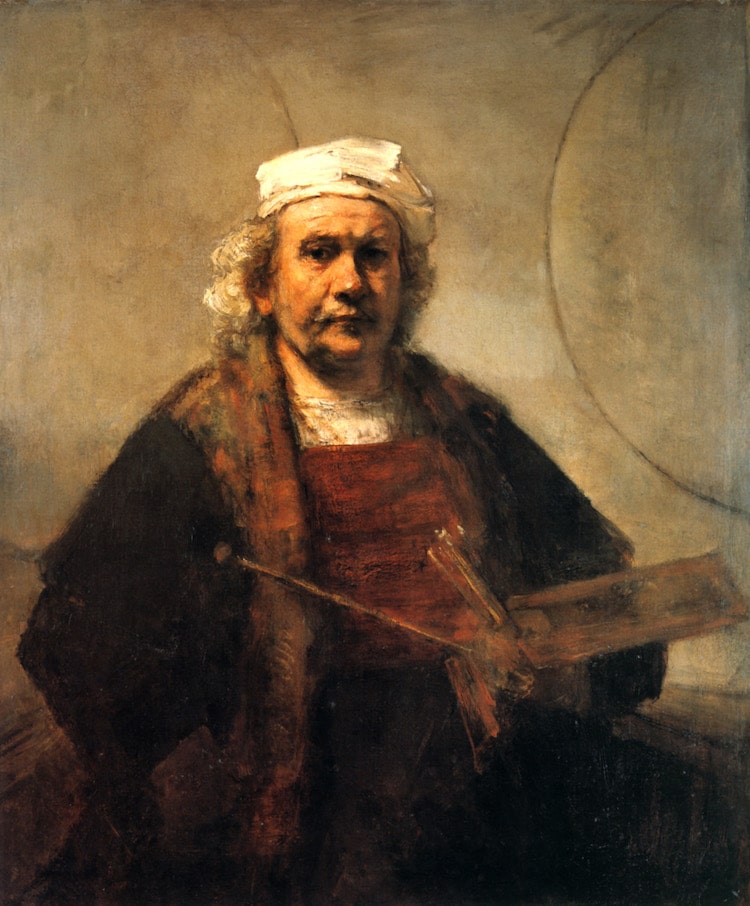
Stock Photos from Kuznetcov_Konstantin/Shutterstock
This post may contain affiliate links. If you make a purchase, My Modern Met may earn an affiliate commission. Please read our disclosure for more info.
Oil paint has a long tradition in art history. Many of the world’s greatest creatives have used this material to produce their masterpieces, and its legacy lives on as one of the most popular media today. If you’ve ever thought about painting or are a professional looking to switch up your practice, chances are that oils have crossed your mind.
Acrylic and oil are two of the most well-known types of paints used by contemporary artists. But what is the difference between acrylic vs oil paints? It all comes down to how they are constructed. Oil paints feature pigments that are suspended in oil (typically linseed) while acrylics have their colors bound using acrylic polymer emulsion. Acrylics can be thinned with water, but oil paints require more care. To thin the pigment or clean your brushes, you’ll have to use turpentine or mineral spirits.
Don’t let the extra work of maintaining oil paints turn you off to them. There are good reasons why artists continue to use them; the pigments are rich in tone and have a lustrous finish to them. Additionally, oil paints are slow to dry and give you time to change your artwork after you’ve laid down an initial brushstroke.
Excited to learn how to oil paint? Check out the basic supplies and essential oil painting techniques that you need to know.
Oil Painting Supplies

Stock Photos from Kuznetcov_Konstantin/Shutterstock
Before you begin to paint with oils, here are some of the supplies you’ll want to have on hand. Chances are that you have some of them if you have painted with acrylic or watercolors before. It is, however, best to have a set of tools that are only for oil-based paint—water and oil don’t mix!
A set of oil paints — You’ll want at least a basic set of hues to get you started. We’ve written a guide on what to look for in a set of oil paints, as well the best oil paint sets to buy.
A set of brushes — Look for many types of brushes that are geared towards oil paints. You’ll want different sizes as well as different shapes. Depending on what you’re painting, you’ll want to switch the type of brush you’re using. A flat brush, for instance, is great for creating layers of solid color while the round size allows you to add a lot of fine details to your work.
Paint palette — The stereotypical palette is a curved wooden board with a hole for your thumb. While that is certainly an iconic object, there are much more comfortable options available. Though plastic palettes are the norm; this one is portable, too, for painting on the go.
Palette knife — The best practice for mixing colors is with a palette knife. Using one will allow you to mix even hues and avoid loading your brush with pigment as you try and mix. You can also use a palette knife to apply textural paint, like artist Anastasia Ablogina.
Canvas — If properly primed, you can use paint with oil on a variety of surfaces. Canvas, however, is the go-to for many artists and what we’d recommend if you’re just starting out.
Turpentine or Turpenoid — To clean your brushes and thin pigment, you’ll need a bottle of turpentine or Turpenoid handy. We recommend Turpenoid because it’s odorless, but make sure you’re still working in a studio with good ventilation.
Understand How to Oil Paint With These Techniques
Once you have all of the basic supplies on hand, it’s time to start working. Here are some of the essential oil painting techniques that everyone should know.
Glazing
Glazing involves painting a thin layer of transparent or semi-transparent paint onto a surface. In doing this, each subsequent layer changes the appearance of the color below and results in a multifaceted hue.
To thin oil paint, you’ll need to use turpentine (or something similar). Alternatively, you can use linseed oil. This will add glossiness to your pigment, unlike turpentine, which can make your color dull.
Underpainting
When painting, there are few things more daunting than a totally blank page or canvas. Underpainting solves this issue by being the first layer of paint applied to a work surface. It serves as a guide for the rest of your picture and establishes where values and tones will go.
With an underpainting, you will start by thinning your paint. Then, using one color with different tones, loosely paint where the major parts of the composition will be. In a sunset painting, for instance, you’ll block out the areas where the trees and hills are. Those will be darker than the sky. That way, when it comes time to apply the paint to the canvas, you’ll know exactly where it will go.
Wet on Wet
There is a lot of waiting time in painting. To apply a new layer of pigment, you must stand idly by while the previous coat of paint is left to completely dry. But with the wet-on-wet technique, you’re exercising the opposite. Also called alla prima, it’s a style of painting in which wet paint is applied to wet paint on the canvas. Impressionists like Claude Monet and post-Impressionists such as Vincent van Gogh used this approach. In working wet-on-wet, it gives you the opportunity to work quickly and mix your layers on canvas. For landscape painting, this is ideal as you can finish the work in one sitting.
Oil painting, with its delayed drying times (it can take days), is ideal for trying wet on wet.
Palette Knife
The palette knife is often used to mix paint, but consider using it as a way to apply pigment to your canvas. Depending on the shape of the trowel, you can create textural strokes that you couldn’t duplicate by brush alone. Because of the hard edges of the palette knife, this technique is best suited for angular mark-making and abstract imagery.
Impasto

Stock Photos from Pressmaster/Shutterstock
Think back to all the times you’ve admired Van Gogh’s paintings. Did you notice how every stroke was visible and the paint stood out from the surface? This is called impasto, and it’s something you can replicate. Using a brush and an excess amount of paint, apply the material in thick layers. Mixing colors on canvas (as opposed to your palette) is also encouraged.
Grisaille
Grisalle is an oil painting approach in which the image is completed in shades of gray or another neutral (but grayish) color. It was popular during the early Renaissance because it mimicked the look of sculpture but was less expensive. Today, the monochromatic technique recalls black and white photography as opposed to sculpture.
Blocking In
Similar to underpainting, blocking in is something you do when beginning a painting. You can start by applying the general colors and shapes of the composition on your canvas using thinned paint and a large brush. In doing so, you are creating a plan for the painting and ensuring that hues and other elements are working in harmony. You can then build on those layers and refine the picture by adding more color and details, or you can leave some of the blocked-in painting exposed to showcase the work’s initial energy.
Chiaroscuro

‘Self-Portrait with Two Circles’ (c. 1665-1669) (Photo: Terry Long.wordpress.com via Wikimedia Commons Public Domain {PD-1923})
Chiaroscuro is the Italian word for “light dark,” and it refers to the balance of light and dark in a drawing or painting. It’s often associated with oil painting because it originated during the Renaissance. Caravaggio and Rembrandt are the artists perhaps best known for using this technique. Their works showcase a strong contrast between dark and light; it’s as if their figures were standing in a pitch-black room and had a single lamp shining on them. The result gives their subjects a three-dimensional feel.
Most figurative oil paintings will use this principle. If someone describes a painting using chiaroscuro, it’s probably because there is a noticeable contrast between dark and light.
Looking for others who love oil painting? Join our Art, Design, Photography, and Drawing Club on Facebook!
Related Articles:
What Is the Difference Between Acrylic vs Oil Paint?
Watch as 200 Years of Varnish Is Wiped Away From a 17th Century Oil Painting
Interview: Textured Oil Paintings Express Complex Human Emotions and Ideas
